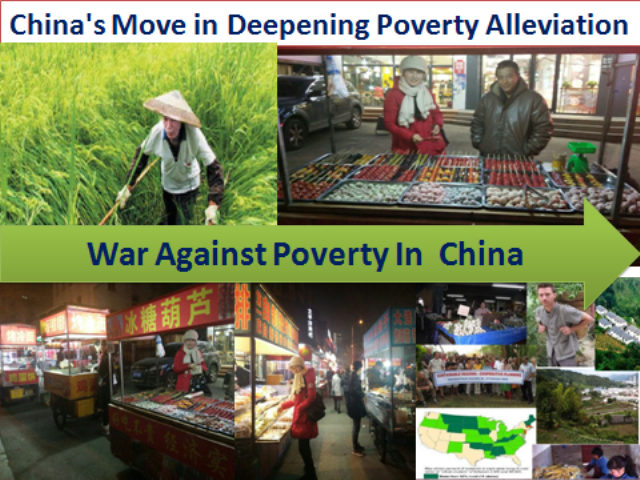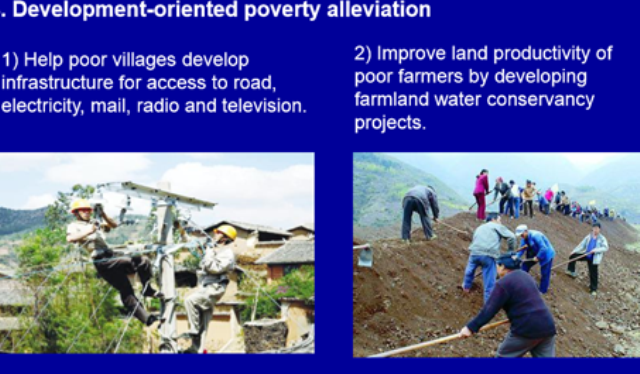Being the second largest economy in the world and the giant of the emerging market, highest trading partner, manufacturing and industrial hub and exporter of huge capital globally, the PR China hasn't just limit itself in maintaining a sustainable economic growth, reducing unemployment rate, cutting down inflation at lower level, achieving a favourable Balance of Payment and addressing environmental externalities like climate change but has also prioritize poverty Alleviation scheme in its governance plan as one of its macroeconomics policy objectives in meeting the demands of the social needs of its citizens. In the past, before the late 70s, development agenda in China were directed to the formal sector with special reference to urban areas with little or no attention directed to the informal sector and rural communities which incubated the high level of poverty by then. Between 1978 and 2005, China has historically made most remarkable progress in poverty alleviation, the rural extremely poor population contracted from 250 million to 125 million with an average annual reduction of 17.86 million. Relatively, poverty incidence went down from 30.7% to 14.8%, averaging 9.4% annually during this period.The proportion of people living in extreme poverty held from 61% in 1990 to 4.2% in 2014. According to the World Bank statistics, more than 500 million people were lifted out of poverty as China's poverty rate fell from 88% in 1981 to 6.5% in 2012, as measured by the percentage of people living on the equivalent of US$1.90 or less per day in 2011 purchasing price parity terms.In 2015, China's raised the poverty line income to 2,855 Yuan approximately US$2 per day and in 2016 it was further increased to US$2.2 per day for a person based on China's estimation core standards and the purchasing power parity referred to as China's concept of poverty line. So anyone below the poverty line is termed to as low income family in the Chinese system. As of 2016, China's demographic statistics recorded a little over 1.3 billion of which about 55.8 million people still live below the poverty line which is the equivalent of the entire population of a medium size country.

Since the founding of new China, especially from the era of launching of reforms and opening up in the late 70s, China has made tremendous progress in poverty alleviation as a result of a sustained economic growth, a series of social policies for equitable development and special programs for poverty alleviation taken by the Government. The fundamental experience is that the Chinese Government adopted and formulated a series of strategies and policies with new insight suited for the country's facts in poverty reduction in shaping a unique poverty reduction mode with Chinese characteristics in five segmented development periods: 1978 to 1985; 1986 to 1992; 1993 to 2000; 2001 to 2015 and now 2016 to 2020.
During the period 1978 to 1985, the rural population living below the poverty line was halved with a decline in the poverty incidence from 30.7% to 14.8% indicating about 50% reduction which can be attributed largely to the success of the rural household responsibility system and the decollectivization of agriculture with the significant of an accelerated expansion in agricultural productivity. The second segment of poverty alleviation started in 1986, but stagnated in the late 1980s and early 1990s. Albeit the government plan during this period to intentionally initiate the large-scale regional development programme to further cut down on the rural poor populace, both the cooling down of economic growth and the concentration of the rural poor hindered the pace of the poverty reduction scheme, which also suffered some setbacks in 1989 and 1991, respectively. The third segment started in 1993 during the announcement of the, 8-7% Poverty Reduction Plan which called for a national strategic action aimed at further reducing the number of the rural poor by 80 million within the period 1994 to 2000. In implementing that programme, the government budgeted special poverty alleviation funds (PAF) consisting of fiscal alleviation funds, food for work funds, and interest-subsidized loans to support economic growth in designated poor areas especially in rural China which succeeded in reducing the population of the rural poor to 32 million with a poverty incidence of 3.4%.

Since the commencement of the new millennium, poverty alleviation in rural China entered the fourth segment(2001-2015) with emphasis of poverty alleviation policies directed to village-based and/or rural household based development programmes rather than the previous county-based schemes aimed at reaching the new remaining rural poor communities directly lifting them out of poverty through both financial utilization and improved targeting.In the verge of effectively fighting poverty, China assigned special poverty relief funds amounting to the sum of 189.84 billion yuan(US$ 28.8 billion) from 2011 to 2015. To make poverty a history by 2020, China pledge to lift 10 million people out of poverty every year starting from 2016 which marks the start of the fifth segment.
Despite the progress and in roads been made in the fight against poverty, China still faces a lot of pressure due to its huge population. As mentioned by the white paper, in China's poverty reduction and human right as of 2016, that currently the number of people who have been lifted out of poverty in the past 30 years has recorded the highest in the history of humanity but yet there are also persistent problems and challenges in China as in remote rural areas in particular that getting programs to the people in terms of inequality in income, inequality in education and economic opportunities in bringing business to those rural remote areas has been a daunting task.As at the end of 2015, there were 14 contiguous poor areas with special difficulties; 832 impoverish counties and 128,000 registered squared villages.

According to the white paper that entails the framework of poverty alleviation in 5 years period started 2016, it clearly outline some of the main challenges that are fraught with the drive towards achieving the desired goals. One of the challenges is setting up the rightful framework to map out the causes to their predicament for a precise Chinese campaign referred to in Chinese language "Chengdu" as the way forward in addressing the most vulnerable and marginalize group of people that exist below the poverty line waiting to be lifted out of poverty by 2020. These includes people who haven't touched by the poverty alleviation program in the past 30 years and are faced with diversify problems ranges from inequality that constitute about 85% of people living in rural areas, access to finances and funding, capacity building, transportation facilities, decent employment opportunities and job creation, infrastructural development and investment and other economic empowerment and better welfare for a more sustainable standard of living. Also added to the white paper there's a provision for the ethnic minority groups who constitute macro of this vulnerable groups moves to other areas for more economically productive activities in meeting their full potentials to attain better economic benefits and welfare empowerment such as infrastructural development, access to good and lucrative jobs, growth in their respective family and domestic economies and better and sustainable standard of living.Currently the poverty reduction program in China is targeting the rural area to tackle the problem of inequality and uneven distribution of wealth.

Photo above is the Research Assistant to this study by the name of Dina Habuken, a third year student majoring in Environmental Science at the College of Environmental Studies, Liaoning University, who has been relentless in undertaken personal interviews with the poverty alleviation beneficiaries particularly small enterprises in Shenyang, Liaoning Province(特别感谢辽宁大学环境学院环境科学专业三年级学生迪娜·哈不肯,她一直坚持本研究的研究辅助工作,对脱贫受益人,特别是辽宁沈阳的小企业进行个人访谈。).
While achieving considerable results in rural poverty reduction, China also sees some new changes in poverty phenomena as liberal mobility and migrant problem has been very crucial in achieving the poverty alleviation campaign. In the cities, there is a huge gap between the floating population and urban residents in terms of education, health, social security and other basic public services. In rural areas, China faces such new problems as left-behind elderly, women and children as well as landless farmers. These problems have posted new challenges to the design of poverty reduction strategies and policies. In response, the Chinese government, while proceeding from equal employment right, labor remuneration right, occupational safety right, social security right, education and training right, children’s education right and residency right, has carried out cross-departmental co-operation by following the basic idea of coordinated urban and rural development. The country is actively and steadily pushing forward the equalization of basic urban and rural public services, unification of the urban and rural social security systems and improvement of the laws, regulations and policy systems that safeguard the employment right of migrant workers. By improving the capacity and systems, China tries its uttermost to prevent the worsening of urban poverty.
Though there is a slow down in the current growth of the Chinese economy from 8% to below since the first quarter of 2016, Government has reaffirmed and reassured its people of its commitment despite the slow down in growth will not affect the speed of achieving and making poverty a history as stipulated in the five years structural plan scheduled to end 2020 which demands huge financing and massive amount of investment in meeting the goals of the Chinese conceptual framework of the poverty alleviation campaign. In achieving this crucial objective, government has put in place an effective nascent social protection platform system that covers over 97% of the population that constitutes specific measures to address the poverty related issues such as; old age pension system that covers over 95% of the population, a minimum living guarantee system in both rural and urban areas providing social protection problems that also addresses other challenges in the case of unemployment and disability with a certainty of having something to count on.

In furthering an effective machinery in the result orientation of the poverty alleviation campaign, China has re-enforced the fight against corruption in bringing all culprits to justice to ensure they minimize the level of inequality and resource allocation to it citizens especially in meeting the demands of the vulnerable people below the poverty line. Also, robust and an effective monitoring and supervision system has been put in place by authorities to monitor and examine the incident of related poverty issues in the various communities to thoroughly mitigate the risk of default of the abuse in the relief agenda.So,this system in the poverty alleviation scheme has been crucial in China's drive to truly eradicate poverty come 2020. Added to the scheme, Authorities have also simultaneously putting a system for the various communities of the poverty relief beneficiary counties to be sustainable after the full implementation of eradicating poverty as scheduled.

Addendum to China's domestic drive of combating poverty, China has also supported other developing countries in the course. In the past six decades, Its has provided about 400 billion yuan to 166 Countries and international organizations; It sent more than 600,000 Aids representative to Overseas given medical assistance to 69 countries especially during the Ebola epidemic response in the West African Sub-region(Sierra Leone, Guinea and Liberia) and aided more than 120 developing Countries in realizing the millennium development and sustainable development goals.
Conclusively, China has made very great geometric leaps in reducing poverty and reaching the benchmarks laid out in both the Millennium Development and Sustainable Development Goals, lifting more than 800 million of its citizens out of extreme poverty over the last three decades to date. Conversely, there are still challenges that needs improvement. Not everyone has been able to benefit equally from the development and economic growth, with rural and ethnic minority areas lagging behind. For China though rapidly progressing and succeeding in combating poverty, it is crucial to adopt a growth pattern that enables poor people to have better livelihoods and to achieve equitable and sustainable development for all. This article is not only gear towards giving an insight about the evolution and features of China's poverty alleviation scheme but also to ring a bell to developing countries especially the Sub-Saharan Africa(SSA) countries' respective governance to look into the Chinese poverty alleviation model which i strongly believe would serve as a very good proxy to adopt in the fight against poverty in Africa which has been the biggest war and disease that has lead to high fatality and mortality rate since the days of our great ancestors.

Sure, i will be waiting for that. How china alleviate poverty from the nation? what are the main tools that lead a nation towards prosperity? i wanna see some stuffs from you. good luck.
Thanks boss, indeed will surely include some of those tools/formulas adopted but that will be in the part 2 of this Article. I deliberately left that part in the first part for the Article not to be too long.
Its a very useful article. i wish if you could include some formulas/tools that how China is moving forward to eradicate poverty? for example; village and border tourism, motivation, cultural promotion, subsidy schemes for farmers, etc. oh yeah, you have submitted some issues like corruption monitoring etc. somehow your hard work is obviously admirable. keep it up.
@TedM you're spot on, indeed attitude is everything because it shapes ones mindset and behavior towards achieving prosperous society or otherwise. As you rightly said, despite the successes made in lifting a lot from the poverty trap but yet China is still fraught with challenges to address such problems you highlighted which is the invisible hand of any society trying to develop itself.
Yeah you are partly correct in all societies in the world you always have those set of people which i normally call 'passengers' who always need free ride but notwithstanding that, it all depends how effective and efficient the poverty alleviation system put in place by government especially in making it sustainable.
I think poverty would exist forever cause there are some people who don't wanna work but still wanna live a good life .. There are much more people of this kind than we imagine ..
Given the right conditions it is relatively easy for a country to develop enough to raise the living standards of its people. It is much more difficult to change its attitudes, behaviours and social structures for the better. With a rising middle class, China faces the problems that prosperity brings as well as its benefits. China has indeed lifted so many out of poverty. Now it faces problems of health care and care of the elderly, as well poor safety in the workplaces and corruption at all levels. The struggle forward carries on.







Comment